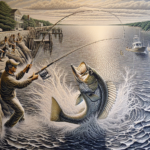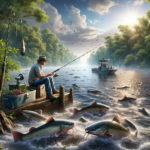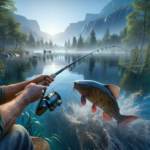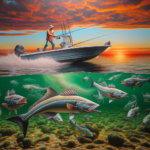Sea Bass Fishing in Massachusetts’ Coastal Waters

Introduction
Did you know that Massachusetts’ coastal waters are home to some of the best sea bass fishing in the United States? Whether you’re a seasoned angler or a novice looking to cast your first line, the Bay State offers a wealth of opportunities to catch this prized species. In this article, we’ll explore the ins and outs of sea bass fishing in Massachusetts, from the best techniques and gear to the top fishing spots and seasonal considerations. By the end, you’ll be well-equipped to make the most of your fishing adventure in these rich coastal waters.
Sea bass fishing in Massachusetts is not just a pastime; it’s a tradition that brings communities together and offers a sustainable way to enjoy the state’s natural resources. Understanding the best practices, regulations, and techniques can make your fishing experience both enjoyable and responsible.
Background/Context
Historical or Cultural Significance
Fishing has been a cornerstone of Massachusetts’ culture and economy for centuries. The state’s coastal waters have long been a source of sustenance and livelihood for its residents. Sea bass, in particular, has been a popular target due to its abundance and the challenge it presents to anglers. Historically, sea bass fishing was a communal activity, often involving entire families and communities.
Geographical Overview
Massachusetts boasts a diverse coastline that stretches over 1,500 miles, featuring a mix of sandy beaches, rocky shores, and estuaries. The state’s coastal waters are influenced by the Gulf Stream, which brings warm waters and a variety of marine life, including sea bass. The local ecosystem is rich and varied, providing an ideal habitat for sea bass to thrive.
Key Points/Details
Fishing Techniques
Technique Overview
When it comes to sea bass fishing, several techniques can be employed, including bottom fishing, jigging, and trolling. Bottom fishing involves dropping baited hooks to the ocean floor, where sea bass are often found. Jigging uses a weighted lure that is jerked up and down to attract fish, while trolling involves dragging baited lines behind a moving boat.
When and Where to Use
Bottom fishing is most effective in areas with rocky or reef-like structures, where sea bass tend to congregate. Jigging can be used in both shallow and deep waters, making it versatile for different fishing spots. Trolling is best suited for covering large areas and is particularly effective during the summer months when sea bass are more active.
Recommended Gear
- Rods: Medium to heavy-action rods are ideal for sea bass fishing.
- Reels: Spinning or conventional reels with a good drag system.
- Lines: Braided lines with a test strength of 20-30 pounds.
- Bait/Lures: Squid, clams, and artificial lures like jigs and soft plastics.
Species Information
Species Overview
Black sea bass (Centropristis striata) is the primary species targeted in Massachusetts’ coastal waters. These fish are known for their distinctive black and blue coloration and can grow up to 24 inches in length. They prefer habitats with structures like reefs, wrecks, and rocky bottoms, where they can find food and shelter.
Best Practices
To successfully catch sea bass, it’s essential to use the right bait and techniques. Live bait like squid and clams are highly effective, as are artificial lures that mimic small fish or crustaceans. Fishing during the early morning or late afternoon can increase your chances of success, as sea bass are more active during these times.
Location Information
Top Fishing Spots
- Cape Cod Bay: Known for its rich marine life and accessible fishing spots.
- Martha’s Vineyard: Offers excellent shore and boat fishing opportunities.
- Nantucket Sound: A popular spot for both recreational and commercial fishing.
- Boston Harbor: Easily accessible and offers a variety of fishing locations.
Regulations and Licenses
Before heading out, it’s crucial to familiarize yourself with local fishing regulations. In Massachusetts, anglers need a saltwater fishing permit, which can be obtained online or at local retailers. There are also specific regulations regarding catch limits and size restrictions for sea bass, so make sure to check the latest guidelines from the Massachusetts Division of Marine Fisheries.
Seasonal Considerations
Seasonal Variations
Sea bass fishing in Massachusetts is highly seasonal. The best time to fish for sea bass is from late spring to early fall, with peak activity occurring in the summer months. During the winter, sea bass migrate to deeper waters, making them harder to catch.
Best Times to Fish
The optimal times for sea bass fishing are early morning and late afternoon, when the fish are most active. Tides also play a significant role, with incoming tides generally offering better fishing conditions.
Events and Tournaments
Event Overview
Massachusetts hosts several fishing tournaments throughout the year, including events specifically for sea bass. These tournaments offer a great opportunity to test your skills and compete with other anglers. Notable events include the Martha’s Vineyard Striped Bass and Bluefish Derby and the Boston Harbor Sea Bass Tournament.
Preparation Tips
To prepare for a fishing tournament, make sure your gear is in top condition and familiarize yourself with the tournament rules. Practice your techniques in advance and scout the fishing locations if possible. Staying updated on weather conditions and tide schedules can also give you an edge.
Tips and Best Practices
General Tips
- Always check the weather forecast before heading out.
- Use a fish finder to locate sea bass more effectively.
- Keep your bait fresh and change it regularly.
- Practice catch and release to help sustain the fish population.
Avoid Common Mistakes
- Using the wrong type of bait or lures.
- Fishing in areas without adequate structure or cover.
- Ignoring local fishing regulations and size limits.
- Not paying attention to tide schedules and weather conditions.
Advanced Techniques
- Using electronic fish finders to locate schools of sea bass.
- Employing advanced jigging techniques to attract larger fish.
- Experimenting with different types of artificial lures to find what works best.
Gear and Equipment Recommendations
Essential Gear
- Medium to heavy-action fishing rod.
- Spinning or conventional reel with a good drag system.
- Braided fishing line with a test strength of 20-30 pounds.
- Live bait like squid and clams, or artificial lures like jigs and soft plastics.
Optional Gear/Upgrades
- Fish finder to locate sea bass more effectively.
- High-quality tackle box to organize your gear.
- Fishing gloves for better grip and protection.
- Portable cooler to keep your catch fresh.
Where to Buy or Rent
Local bait and tackle shops in Massachusetts offer a wide range of fishing gear and equipment. Some popular stores include Goose Hummock Shop in Orleans, Red Top Sporting Goods in Buzzards Bay, and Surfland Bait and Tackle in Newburyport. Many of these shops also offer rental options for those who prefer not to invest in their own gear.
Safety and Conservation
Safety Tips
- Always wear a life jacket when fishing from a boat.
- Be aware of weather conditions and avoid fishing during storms.
- Use sunscreen and stay hydrated to protect yourself from the sun.
- Keep a first aid kit on hand for emergencies.
Conservation Practices
- Practice catch and release to help sustain the fish population.
- Respect local wildlife and avoid disturbing their habitats.
- Follow all fishing regulations and size limits.
- Dispose of fishing line and other waste properly to protect the environment.
Planning Your Trip
Accommodations
Massachusetts offers a variety of accommodations near popular fishing spots, ranging from hotels and motels to vacation rentals and campgrounds. Some recommended places to stay include the Harbor View Hotel in Martha’s Vineyard, the Chatham Bars Inn on Cape Cod, and the Boston Harbor Hotel in Boston.
Travel Tips
Massachusetts is easily accessible by car, plane, and public transportation. Major airports include Logan International Airport in Boston and T.F. Green Airport in Providence, Rhode Island. If you’re driving, the state’s well-maintained highways make it easy to reach coastal areas. Public transportation options like buses and ferries can also help you get to your fishing destination.
Additional Activities
In addition to fishing, Massachusetts offers a wealth of other activities for visitors. Explore historic sites like Plymouth Rock and the Freedom Trail, enjoy outdoor activities like hiking and kayaking, or visit local attractions like the New England Aquarium and the Cape Cod National Seashore.
Frequently Asked Questions (FAQs)
Do I need a fishing license to fish for sea bass in Massachusetts?
Yes, a saltwater fishing permit is required for all anglers over the age of 16. You can obtain a permit online or at local retailers.
What is the best time of year to fish for sea bass in Massachusetts?
The best time to fish for sea bass is from late spring to early fall, with peak activity occurring in the summer months.
What type of bait should I use for sea bass fishing?
Live bait like squid and clams are highly effective, as are artificial lures that mimic small fish or crustaceans.
Are there any size or catch limits for sea bass in Massachusetts?
Yes, there are specific regulations regarding catch limits and size restrictions for sea bass. Make sure to check the latest guidelines from the Massachusetts Division of Marine Fisheries.
Conclusion
Sea bass fishing in Massachusetts’ coastal waters offers a rewarding experience for anglers of all skill levels. By understanding the best techniques, gear, and locations, you can make the most of your fishing adventure. Remember to follow local regulations and practice sustainable fishing to help preserve this valuable resource for future generations. Whether you’re planning a trip to Cape Cod, Martha’s Vineyard, or Boston Harbor, Massachusetts’ rich coastal waters are waiting to be explored. So grab your gear, head out to the water, and enjoy the thrill of sea bass fishing in the Bay State!




